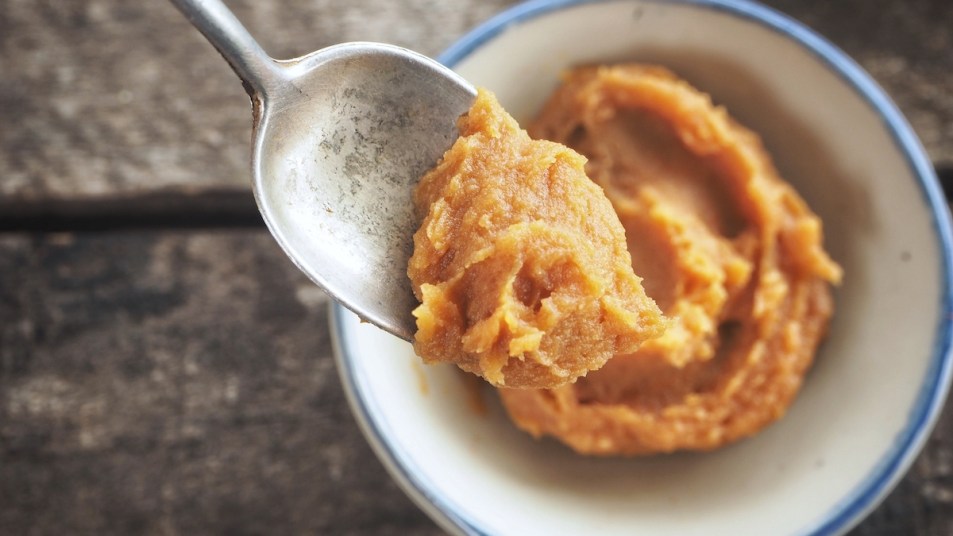Miso Paste Makes More Than Just Soup — Here’s How To Use It
It promotes gut health and adds instant savory flavor to any dish.

If you like sushi, you’re probably familiar with miso soup. Made with tofu, seaweed, scallion, and a subtle yet distinctive broth, it’s both simple and satisfying. Miso soup’s key component, however, is miso paste. It’s what’s responsible for the soup’s name and signature taste, and it appears in all kinds of recipes — you can even incorporate it into desserts. Read on to learn more about miso and how to use it.
What is miso?
Miso is a paste made from fermented soybeans. While it’s hard to describe the flavor, as is so often the case when it comes to umami ingredients, it’s typically described as earthy, toasty, savory, and (my personal favorite) funky. The condiment has an incredibly long history, and has been a staple of Japanese cooking for centuries. According to Bon Appétit, it “goes back millennia in Japan, where a bureau to regulate its production, trade, and taxation was established by Emperor Mommu in 701 (!), and traditional miso-making is an art form.” In recent years, miso has become increasingly easy to find at grocery stores and online, and many home chefs have discovered just how versatile it can be.
Today, the ancient spread is beloved not just for its versatility and taste but also for its health benefits. Because it’s fermented, it may help to support gut health. It’s also relatively low in fat, calories, and carbs, and it contains manganese, vitamin K, copper, and zinc. Additionally, the fact that it’s made from soybeans means it’s high in protein. While it has a good deal of nutritional value, it should be noted that miso is high in sodium, as the soybeans have been fermented with salt. This imparts great flavor, but if you’re watching your sodium intake, keep it in mind.
Miso paste has a thick consistency similar to peanut butter, and comes in light and dark varieties. You’re most likely to encounter white, yellow, and red versions. Here’s a brief guide to each type:
- White. This variety (which is more yellow than white) is fermented for a shorter period of time than other types, giving it a milder taste. It isn’t as salty as darker varieties, so it doesn’t overwhelm your palette. Because of this, it’s a great choice to start with if you haven’t used miso before.
- Yellow. This type of miso is light brown in coloring, and has a nice in-between level of flavor that’s not too mild or too bold. It definitely has a savory kick, but it’s not going to overshadow other flavors you cook with.
- Red. The most pungent miso of all, this variety tastes quite salty and packs a powerful punch even in small doses. It’s usually a dark brownish-red shade. When you want a strong miso flavor that’s tangy and complex, this is what you’d use.
Recipes that use miso paste will often specify a certain color, but you can use them interchangeably if you’d like. Just be sure to taste your dish along the way, as using a dark miso in place of a light one may change the intended flavor of your dish.
If you buy a container of miso and don’t use it up right away, don’t worry — because it’s preserved with salt, miso can stay good in your fridge for up to a year. If you have a container of miso on hand, you can make a marinade for meat, fish, tofu, or vegetables in a flash.
What can I make with miso?
Miso is a powerhouse ingredient. It amps up otherwise “meh” meals with a savory kick. The Five-Ingredient Creamy Miso Pasta from The New York Times is a one-pot wonder, and chances are good your kids or grandkids will like it as much as you do. Maple and Miso Sheet-Pan Salmon is another crowd-pleaser; the saltiness pairs beautifully with the sweetness of maple syrup. If you like big and fiery flavors, Spicy Miso Grilled Chicken will make your mouth water. The ingredient is also beloved by vegetarians and vegans for the way it adds complexity to a dish without using any animal products, and a meal like this Rice Bowl With Oven-Baked Miso Tofu exemplifies the way tofu soaks up miso’s distinctive flavors.
You can also use miso to make marinades and salad dressings. If you’re feeling adventurous, try making a cocktail or dessert (Peanut Butter-Miso Cookies and Sweet Potato-Miso Pie With Chocolate-Sesame Crust both sound enticing). Once you start cooking with miso, you’ll find that it can be used in countless creative ways. Here’s a perfect starter recipe: Easy Miso Sauce For Everything.
Easy Miso Sauce (For Everything)
Ingredients (Serves 2):
- 2 teaspoons white miso
- 2 tablespoons rice vinegar
- 1 tablespoon maple syrup
- 1 teaspoon low sodium soy sauce
- ¼ teaspoon minced garlic
- ¼ teaspoon ginger (fresh or ground)
Instructions:
Combine all ingredients in bowl and whisk together until smooth. Sauce can be poured into airtight container and stored in fridge up to three weeks.
As its name (“Easy Miso Sauce For Everything”) suggests, you can serve this with whatever dish you like, or easily use it as a marinade. With just a few minutes of work, you’ll have a sauce that’s tasty and good for your gut health — that’s the magic of miso!












